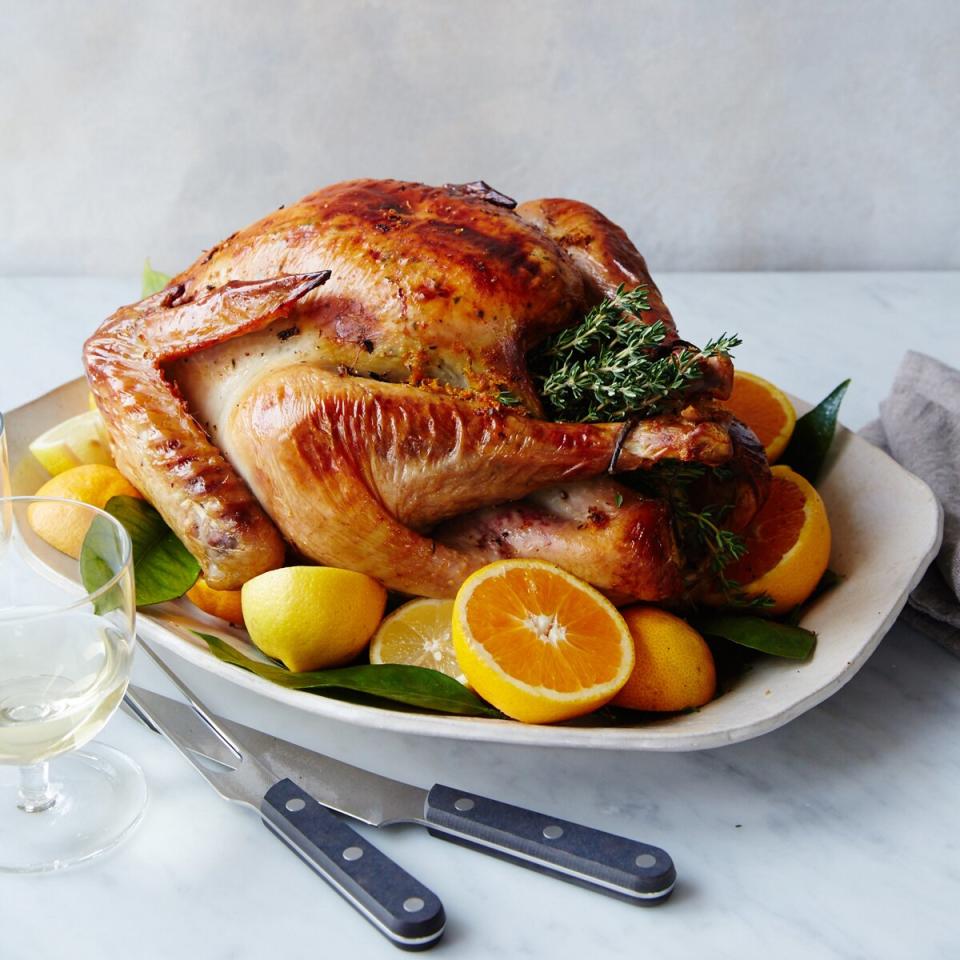How to Make the Juiciest Thanksgiving Turkey
When it comes to Thanksgiving turkey, nothing beats ultra-crispy skin and juicy meat. On this week's episode of Mad Genius, Food & Wine Culinary Director at Large Justin Chapple prepares a recipe that has both, all thanks to an easy trick.
"I'm gonna let you in on a Thanksgiving secret," Justin says. "The trick to the juiciest bird with the crispiest skin isn't basting. It's this [picks up cheesecloth], cheesecloth."
For his Citrus-and-Butter Turkey, he takes three citrus fruits—grapefruit, orange, and lemon—and adds their zest and juice to butter, creating a flavor-packed spread that will not only go on the turkey (both over and under the skin) but a piece of cheesecloth as well. The butter-soaked cheesecloth is then draped over the bird, which roasts for just over two hours, resulting in a turkey that Justin calls "irresistible." It would make an impressive addition to your holiday menu, and we've outlined all of the steps below so you can pull it off at home.
Season Your Turkey
To get started, rinse your turkey—you'll want a 12-to-14 pound bird—and pat it dry. Then, season it inside and out with kosher salt and black pepper, and transfer it to a rack set within a roasting pan. Allow it to come to room temperature while you make the citrusy butter.
Prepare the Citrus Butter
Next, heat a medium saucepan and melt the unsalted butter. In the meantime, zest and juice your three different citrus fruits and whisk the zest and juice into the melted butter. Finely grated garlic cloves go in too, along with minced fresh thyme. Let the butter cool slightly and then transfer half of it to a small bowl, refrigerating it until it's spreadable.
Butter. That. Turkey.
And now, for the main event—spreading that chilled citrus butter all over the turkey. First, you'll want to loosen the skin around the breast and the thighs. Then, use a spoon to slide dollops of butter under the skin, and move your fingers over the skin to evenly distribute it and spread it out. Be sure to spread the butter over the breast and thighs as well. Then, stuff the turkey cavity with the grapefruit, orange, and lemon wedges, plus the thyme sprigs.
Enter the cheesecloth. Before soaking it in the melted citrus butter, dampen it and then wring out any excess water. This will not only prevent the cheesecloth from soaking up too much butter, but also help prevent cloth threads from transferring onto the meat. Soak the cheesecloth in the melted butter and then drape the cloth over the turkey breast and legs. Take any remaining melted butter and drizzle it right on top.
Roast and Rest
The turkey is roasted in two stages. First, in the pre-heated 400°F oven for about 30 minutes; after chicken stock (or low-sodium broth) is poured into the roasting pan, continue to roast it for about another hour and 45 minutes. When an instant-read thermometer is inserted in the inner thigh, it should register 165°F.
Once the turkey has reached temperature, remove it from the oven, carefully peel off the cloth, and transfer it to a board. It may be tempting to cut into it right away and try a piece, but give it 30 minutes to rest. Don't throw out those pan juices, either—skim the fat off of them and transfer them to a gravy bowl so you can enjoy them on the turkey.

© Nicole Franzen
Carve and Serve
After the turkey has had time to rest, carve it and then arrange the pieces on a platter with citrus slices and thyme sprigs for garnish.
"This is irresistible," Justin says as he tries a piece. "The turkey is juicy, the skin is crisp, and believe it or not, all of that citrus, that grapefruit, that orange, that lemon, really shines."
